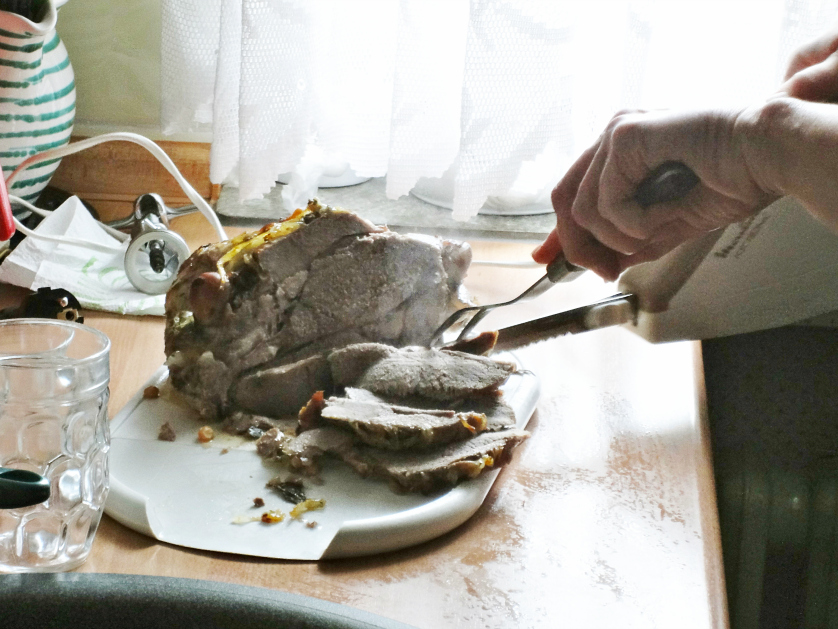
Last Sunday we celebrated Easter as everyone else.
You see rabbits and eggs when it comes to Easter.
Although I'd been always wondering why eggs and rabbits should be appearing for the season, I couldn't help asking people the reason since I came to Germany and got to experience it.
This time it was the first time that I searched for easter tradition because I couldn't get any convincing answers from anyone and Jan didn't also know it.
It can be the same thing that I can't answer every single thing of events related to Shinto and Buddhism. (I even belong to neither Shinto nor Buddhism.)
First of all, do you know why they call it Easter? It doesn't derive from a point of the compass but from an old story that in time of Spring, ancient European had presented and worshiped goddess Ostera (also called Easter: Easter is called "Ostern" in German).
Chocolate eggs and colored eggs are very popular for easter and you can find many tables with eggs on it or decorated with eggs.
In the morning parents are hiding colored eggs and sweets in the gardens or homes and children have to search for them. Parents are telling their kids that the " Easter Rabbit " came and hide the eggs and sweets. Its like the fairy tail of Santa Claus.
But the story of the Easter Rabbit comes from the ancient german time. The fairy tale says that a grandma was hiding easter eggs in the garden and there was a rabbit at the same time.
The kids saw the rabbit and thought that the rabbit is hiding the eggs.
Because of that fairy tale the story of the Easter Rabbit came up and is still popular with young children.
A common dish for easter lunch is lamb. The reason for eating lamb is that a lamb has always been characterized as symbol of pureness and innocence of Jesus for many years. In the old Testament you find the story that the ancient christians and jewish killed and worshiped the lamb and served the meat on the day after he came back from the death.
For many people nowadays the lamb isn't so popular anymore for easter but for greek orthodox for example it still means a lot for them to worship a lamb for the third day of easter.
I find it's a bit funny that even though the lamb is regarded as Jesus people still eat it.
4月20日、こちらはイースター(復活祭)を祝う日曜日でした。
このイースターの季節になると必ず登場するウサギと卵。
以前から疑問には思っていたのですが、キリスト教であるドイツに来てから周りの人に聞き出さずにはいられなくなりました。
でも納得できる答えを得られず、知ってなきゃいけないはずのじょんも「え、知らない笑」って調子だったのでいい加減自分で調べました。笑
私も仏教や神道に関わる行事で答えられないことなんて考えたら切りがないので同じことですね。
まず"イースター"という名前です。Easterだから方角の東が関係あるのかというとそうではなく春の訪れるこの季節に、古代ヨーロッパ人は女神Ostera (Easterとも言う:ドイツ語でイースターはOstern)を崇め奉ったことに始まります。
お菓子でも卵形のチョコレートなどが街にあふれ食卓にも出る卵ですが、卵は「新しい生命」を象徴しています。
キリスト教圏の国では、イースターの時期に子どもたちはゆで卵を染めたりし、大人が卵を庭に隠し子どもたちがそれを探す「エッグハント」という「たまご探し」をします。
ウサギがイースターを象徴するのはドイツの昔話が起源だそうで、ある年のイースターにおばあさんは卵を庭に隠しエッグハントをしていると、野ウサギが庭を飛び跳ねていました。それを見た子どもたちは、野ウサギがイースターエッグを配っているのだと思い、これがイースターバニーの由来になったそうです。
今回ご馳走になったラム(子羊)にもちゃんと理由があります。
羊は、イースターに限らず、「無防備さ」の象徴で、古くから、特に旧約聖書で生け贄(犠牲)の動物と見なされてきました。
キリスト自体も神の子羊」と称され従順な羊に例えられました。
ユダヤ教では神の記念日に子羊を屠殺し、祭壇に捧げ、古代キリスト教でも、子羊の肉は祭壇に捧げられ、同じ肉は復活の日、最初の食事として供されました。なぜなら、子羊は「神の子羊」として、無実・潔白のキリストを象徴しているからです。
現在では、ラムはイースターの慣習では表舞台から退いてしまいましたが、ギリシア正教では、イースターラムはまだまだ非常に意味を持っています。
16世紀半ばまではラム炒めがイースターの食事のメインディッシュだったそうですが、この習慣は変わり、兎も復活祭を祝うのに食べられるようになりました。
だからってキリストに例えた神聖な子羊をキリストの復活を祝って食べちゃうんだ。。と思ってしまいますけど。
More Photos!☟

At Jan's parents
じょんの両親の家で
じょんの両親の家で






This time Jan's mom made it all by herself.
She used an old Greek Easter recipe.
I didn't get to see the recipe she used but I found a similar one to share with you (recipe in German).
今回はじょんのお母さんの手作り料理でした。
古いギリシャのイースターレシピを使ったそうです。彼女の使ったレシピは見せてもらいませんでしたが、それらしいものを見つけたので載せておきます(ドイツ語)。








xoxo
M




No comments:
Post a Comment